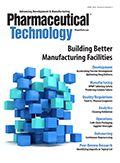Manufacturing APIs and the Supply Chain
Pharmaceutical Technology spoke with Jens Andersson, purchasing director at Cambrex Karlskoga, about the best way to ensure the security of the bio/pharmaceutical materials supply chain.
Pharmaceutical Technology spoke with Jens Andersson, purchasing director at Cambrex Karlskoga, about the best way to ensure the security of the bio/pharmaceutical materials supply chain.
PharmTech: What is the contract manufacturing organization’s (CMOs) responsibility in ensuring the quality of materials they use in the production of APIs?
Andersson (Cambrex Karlskoga): Cambrex prefers to take full responsibility for ensuring the quality of the raw materials that are used in our manufacturing processes. Ultimately, we are responsible for the quality of the final API produced at our sites and ensuring that it meets customers’ specifications. Therefore in our opinion, it makes sense that we take the responsibility to source raw materials of the correct quality to undertake the campaign or product. We also find this process to be quicker and more cost-effective than if the end customer undertakes the sourcing and sends material to us, as we can use our own supplier network and can use suppliers with which we have a well-established relationship without having to necessarily qualify new suppliers.
PharmTech: What are the steps and/or best practices for qualifying suppliers?
Andersson (Cambrex Karlskoga): There are several steps that are undertaken when we qualify suppliers, with the first being to evaluate the quality of raw materials against the specifications to ensure that they meet both the stated purity and the demands of the project we intend to use the materials for. Then we send questionnaires to the suppliers that cover a wide range of topics, from quality to health and safety practices, as well as environmental policies and responsibilities, and ethical guidance of the company. If needed, audits are carried out on-site by our QA [quality assurance] specialists for suppliers of raw materials with critical impact on the final product quality, such as the main building blocks of the final API.
PharmTech: How often should suppliers be audited?
Andersson (Cambrex Karlskoga): For critical raw materials and services we re-evaluate suppliers every two years. We carry out on-site audits every two to three years depending on how critical the raw material or service is; however, audits can also be initiated outside of the regular schedule for other reasons, such as quality or supply issues.
PharmTech: What additional challenges do high-risk materials pose? Does the oversight of these suppliers intensify?
Andersson (Cambrex Karlskoga): The main challenge is that for suppliers of critical raw materials we need to make a much more thorough initial qualification and risk assessment. This can be time consuming and, at times, it can be difficult to get the data and information needed. At Cambrex, we do have a robust supplier network where we have been able to establish strong relationships over a number of years that mitigates this risk.
PharmTech: When there have been reports of suppliers falsifying certificates of analysis (CoAs), how can a pharma company or contractor be sure the information they are receiving from a supplier is correct? Is this why testing of materials is important?
Andersson (Cambrex Karlskoga): For critical raw materials, we will always carry out our own analyses to confirm the vendor’s CoA and ensure the quality of the material. For less critical raw materials such as common solvents or regularly used bulk acids and alkalis from reliable and trustworthy vendors, goods can be received only on CoA, but we will undertake random tests to ensure the CoAs.
PharmTech: What should a pharma company or contractor do when FDA puts a supplier on import ban? Should companies have a backup plan to prevent product shortages?
Andersson (Cambrex Karlskoga): A company needs to be proactive and should always aim for dual sourcing capabilities for critical raw materials, so that any risk of supply is minimized. A risk assessment should always be carried out to evaluate the danger of interrupted deliveries.
PharmTech: What has the recent NDMA impurity issue taught the industry about materials quality and the importance of testing materials?
Andersson (Cambrex Karlskoga): Given that the situation with the NDMA is still ongoing, it is too early to say what lessons need to be learned from it. However, in 6–12 months the situation will hopefully be clearer, allowing for a detailed review to take place and evaluation of any future risks to be made. It is paramount that patient safety is the highest priority so the industry as a whole has a duty to ensure that decisions are made that do not compromise this in any way, and that any oversights that have been made previously do not happen again.
Article Details
Pharmaceutical Technology
Vol. 44, No. 4
April 2020
Pages: 76
Citation
When referring to this article, please cite it as S. Haigney, "Manufacturing APIs and the Supply Chain," Pharmaceutical Technology 44 (4) 2020.
